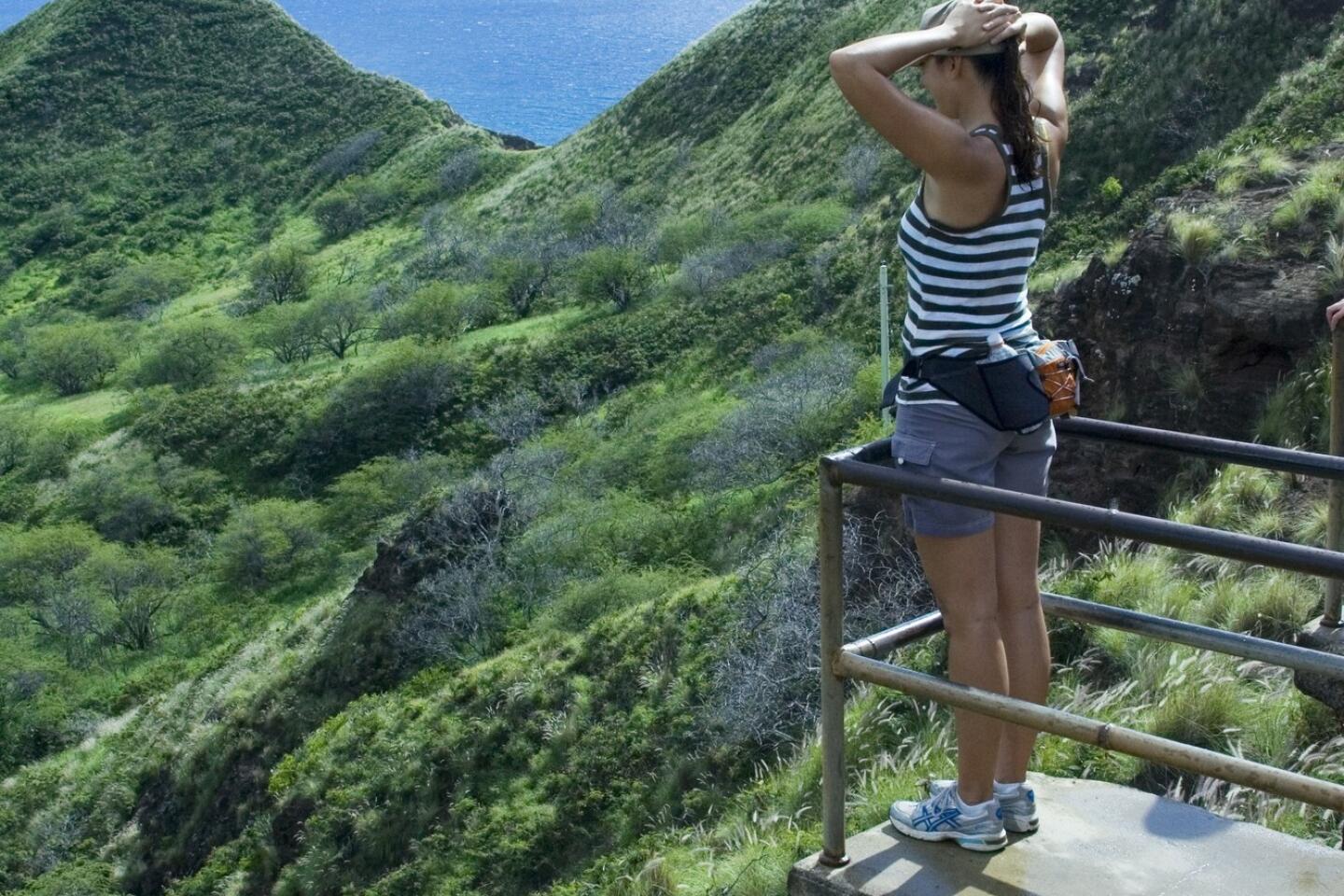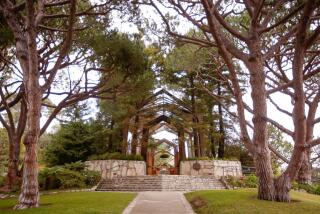Diamond Head hike offers commanding Hawaiian vistas
As I kayak just off the west end of Waikiki Beach, I’m trying to imagine how Diamond Head, a hulking 762-foot-high mass of magmatic debris, might have appeared in the 11th century. That’s when the first Polynesian visitors are believed to have navigated these turquoise waters.
No doubt whoever first laid eyes on what Hawaiians call Le’ahi, a contracted form of lae, or point of land, and ahi, yellowfin tuna (for the fin-like-shaped ridgeline), must have gasped loud enough to be heard in Honolulu Bay.
OK, I’m exaggerating, but you won’t want to miss a seafarer’s perspective of the inaccurately dubbed “Diamond Head.” British sailors in the early 1800s mistook the calcite crystals on the crater’s slopes for diamonds, thus naming it Diamond Hill.
Gemological faux pas aside, Leahi is technically termed a tuff cone by vulcanologists. It’s thought to have originated 400,000 to 500,000 years ago “in a series of explosive blasts after rising magma (liquid rock) and dissolved gas came into contact with shallow seawater or water in rocks close to the sea’s surface” writes Denby Fawcett in “Secrets of Diamond Head: A History and Trail Guide.”
With the powerful sun illuminating every craggy edge of the 3,500-foot-diameter crater, it’s easy to see why Diamond Head is the most recognized landmark on Oahu and perhaps the entire Hawaiian island chain.
Diamond Head State Monument coordinator Yara Lamadrid-Rose describes the site as “one of Hawaii’s most iconic geologic features and a landmark destination. Its unique profile has been the subject of countless photographs, movie backdrops, posters and postcards,” she says.
In fact, each year some 900,000 visitors hike up staircases and through tunnels to soak themselves in Diamond Head’s rich history and sweeping, 360-degree views that extend all the way to Maui.
Judging from the busloads of safari hat-wearing and camera-clutching hordes exiting the parking lot just steps from the trailhead, it seems as if a good chunk of those visitors had arrived much earlier. I’d made mistake No. 1 for visiting Diamond Head: showing up way too late to find a parking space.
Instead of leaving my car at the bottom of the hill and adding another couple of hours to hike to the trailhead, I opted to follow the attendant’s sage advice: return between 6:30 and 7 a.m.
She was right. I arrived just before 7 a.m. on the following day and managed to get the last parking spot. More important, the morning light was more engaging and the air was cool enough to warrant a light sweatshirt.
At just 1.6 miles round trip and a 560-foot elevation gain, the Diamond Head Summit Trail is not especially challenging. Most anyone with a modicum of fitness can handle the 45- to 60-minute hike through dry scrub reminiscent of the African veld. Yes, you’ll start with concrete underfoot and a less-than-charming chain-link fence.
Soon, though, the pavement ends and the path starts winding upward through several switchbacks. After just 10 minutes, I’m at the first major overlook surveying the Koolau Range and the cloud-rimmed Pacific in the distance.
Huffers and puffers, take note: The vista spot has three benches where you can catch your breath and meditate on the tableau in front of you, as well as the monument’s military history. Here, sitting on a concrete platform, is a hulking winch and cable that was used to haul building materials up Diamond Head’s steep slopes.
You may have come for the stunning panorama, but it was this natural feature that first caught the attention of the U.S. government. In 1904, the feds paid some $3,300 to transform the nearly 500-acre crater into a military reservation.
Author Fawcett says most people don’t realize there’s much more to Diamond Head than the trail: “The hikers are unaware they are in the midst of dozens of concealed military structures dating back to before World War I. Diamond Head is honeycombed with about 20 hidden tunnels excavated into the crater’s lava and ash.
Inside the crater, Ft. Ruger was constructed to house cannon mortars along with a telescope station, while the rim provided a naturally strategic location ideal for protecting against land and sea-based attacks. In addition, artillery batteries were placed at several levels connected to this very trail you are navigating, hand-carved in 1910 to access a fire-control station at the top.
Considered an engineering marvel at the time, the station served as an observation and command center housing instruments and gun positions. Not one shot was fired through both world wars, and in 1950 all weaponry was removed and control of Diamond Head passed to the National Guard before being declared a National Natural Landmark in 1968. Eight years later, the crater was opened for recreational use.
Continuing on the hike, those of you most interested in sky-gazing must be patient as 74 steps await you, followed by a 225-foot tunnel with just enough lighting to assess your fellow hikers’ calves. (Bring a flashlight if you’d like to see more or are afraid of the dark.)
I promise this is not some secret CrossFit initiation, but be prepared for lots of stairs, starting with 99 steps leading to the lowest level of the fire control station. From there, a metal spiral staircase brings you to the lookout, where you’ll exit limbo-style through the viewing slits that were once covered with metal shutters. The final 54 metal stairs bring you to the peak. You may tire of all the steps, but it beats the ladder that was used until the 1970s.
A loop trail down — yes, with more stairs — brings you back to the tunnel for the return. But don’t rush. From this vantage point, you’ll enjoy taking in the coastline to Koko Head and the offshore islands of Molokai, Lanai and Maui.
But it’s the outline of Hawaii’s capital that inspires most. Like many cities, Honolulu looks best when viewed from afar. The summit, six miles from the city center, is just far enough to place the “sheltered port” (the English translation of Honolulu) in its proper context: skyscrapers framed by slowly rolling half- mile-long waves and gently sloping volcanic terrain topped with puffs of cumulus clouds set against a cobalt sky.
Fawcett ends her book by writing that “Diamond Head is to Oahu as the Sphinx is to Cairo, an enduring symbol … as symbolically important to Hawaii as the Eiffel Tower is to Paris.”
If you go
THE BEST WAY TO HONOLULU
From LAX, United, American, Hawaiian and Delta offer nonstop service to Honolulu, and United, Hawaiian, Delta and Alaska offer connecting service (change of plane). Restricted round-trip fares from $635, including taxes and fees.
Diamond Head State Monument (bit.ly/1o0fZxp) is open 6 a.m. to 6 p.m. daily, including holidays. The entrance is off Diamond Head Road between Makapuu Avenue and 18th Avenue. The trailhead is adjacent to the parking lot, with the last entrance at 4:30 p.m. Admission is $5 per vehicle or $1 per walk-in visitor, cash only.
More to Read
Sign up for The Wild
We’ll help you find the best places to hike, bike and run, as well as the perfect silent spots for meditation and yoga.
You may occasionally receive promotional content from the Los Angeles Times.








